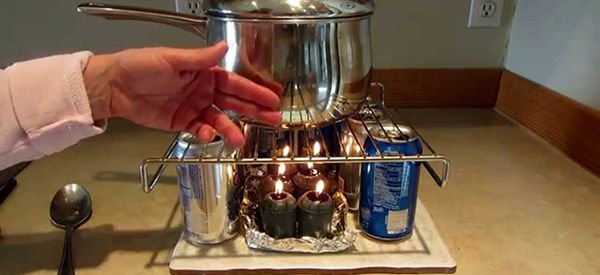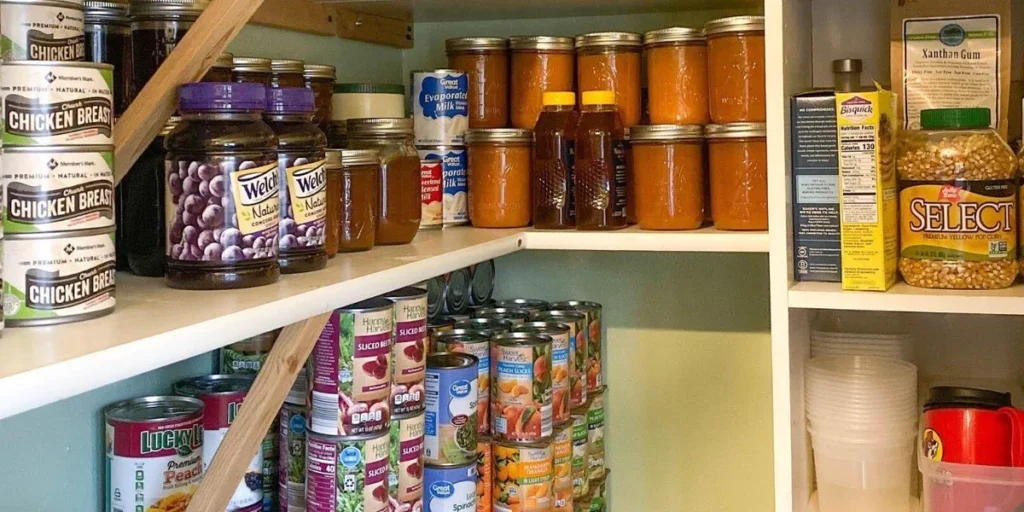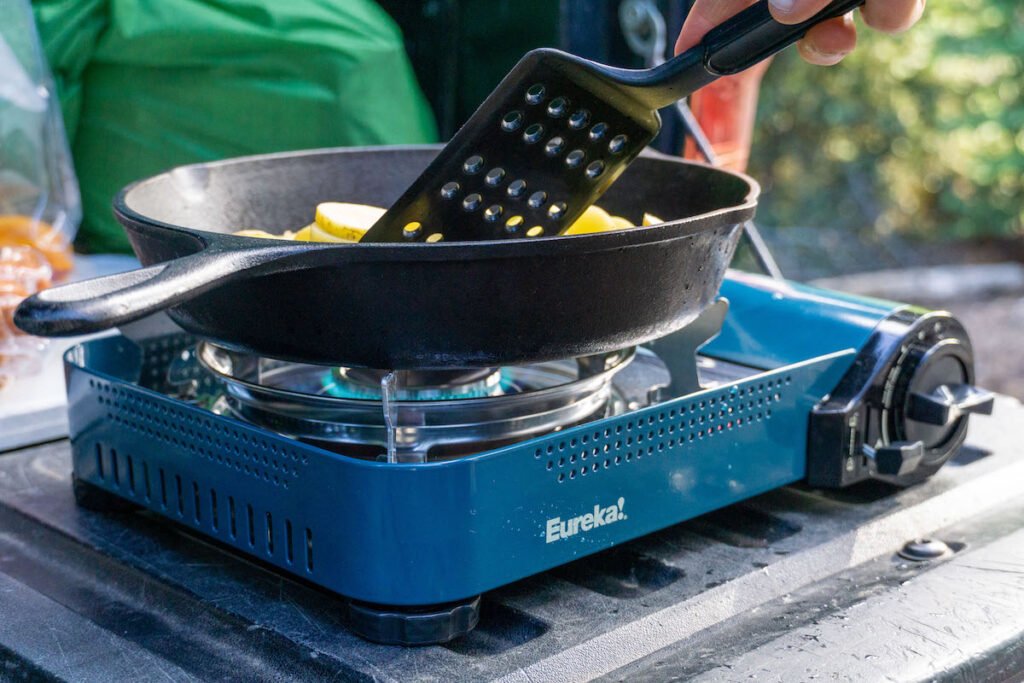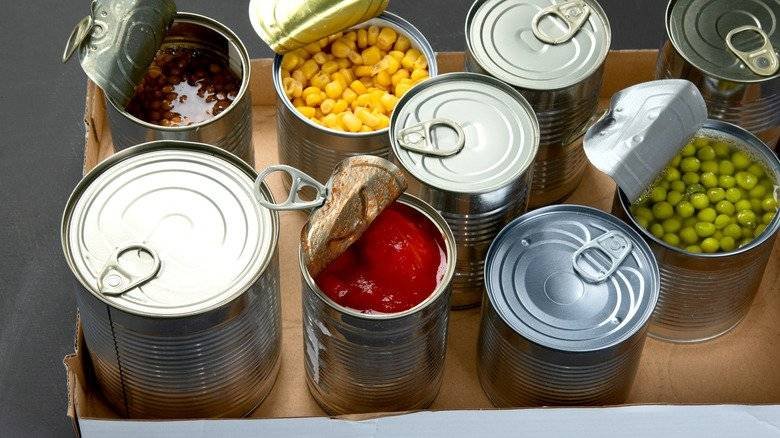When it comes to preparing an emergency food supply, it’s essential to consider not just the food itself but also how to cook it. Knowing the right techniques and tips can make a significant difference in ensuring that you can prepare and cook your emergency food supply effectively.
In this guide, I will provide you with all the necessary information to help you become a pro at how to cook emergency food supply.
Key Takeaways:
- Understanding the cooking time for freeze-dried foods can help you plan and ensure quick meals during emergencies.
- Having food items in storage that do not require cooking can be beneficial for convenience and energy conservation.
- Investing in necessary cooking equipment, such as a portable kitchen gas stove, can make emergency cooking easier and safer.
- Building an emergency food pantry with shelf-stable items ensures that you have a variety of food options for extended periods.
- Water storage and purification are crucial components of emergency food preparation to ensure hydration and cleanliness.
Table of Contents
Essential Cooking Tips for Emergency Food
When it comes to cooking emergency food, there are some essential tips and techniques that can make the process easier and more efficient.
Whether you’re facing a power outage or a natural disaster, these cooking tips will help you prepare quick and nutritious meals in emergency situations.
1. Opt for Quick-Prep Meals
In emergency situations, time is of the essence.
Look for easy recipes that require minimal cooking time and preparation.
Stock up on freeze-dried foods that can be rehydrated quickly by adding hot water.
Most of these meals can be ready to eat within 10 to 12 minutes, providing you with a convenient and nutritious option.
2. Don’t Overcook Water
When boiling water for cooking or rehydrating food, it’s important to note that bringing water to a boil will destroy harmful pathogens.
There’s no need to boil it for longer than necessary, which not only saves fuel but also preserves the nutrients in your food.
Follow the instructions on your emergency food packaging for the recommended water temperature and duration.
3. Include No-Cook Food Items
While it’s important to have a way to cook your emergency food, it’s also beneficial to have food items in storage that do not require cooking.
This can include ready-to-eat canned goods, protein bars, dried fruits, and nuts.
These items provide a quick and easy source of nutrition when cooking may not be an option.
| Quick Meals for Emergency Situations | Ingredients | Instructions |
|---|---|---|
| Instant Oatmeal | Instant oatmeal packets, water |
|
| Tuna Salad | Canned tuna, mayonnaise, pickle relish, crackers |
|
| Peanut Butter and Jelly Sandwich | Peanut butter, jelly, bread |
|
Necessary Equipment for Cooking in Emergencies

In order to cook effectively in emergency situations, it’s crucial to have the necessary equipment.
Being prepared with the right tools can make all the difference when it comes to cooking your emergency food supply.
Here are some essential items you should consider having:
- Portable Kitchen Gas Stove: A reliable heating source is essential for cooking during emergencies. A portable kitchen gas stove allows you to cook your meals efficiently and safely. It’s compact and easy to use, making it a great addition to your emergency kit.
- Stove In A Can: Another option for a heating source is a Stove In A Can. This portable stove is lightweight and can be easily stored in your emergency pantry. It provides a convenient way to heat food when traditional cooking methods are not available.
- Salt and Sugar: These basic ingredients are essential for adding flavor to your emergency meals. They can help improve the taste of your food and make it more enjoyable to eat.
- Grain and Mill: Consider investing in a grain and mill to make your own flour. Flour does not store well long-term, so having the ability to make fresh flour can be invaluable. It allows you to bake bread and other baked goods using your emergency food supply.
Having these essential cooking equipment and ingredients will ensure that you are prepared to cook your emergency food supply effectively.
They give you the ability to create meals that are not only nutritious but also tasty, even during challenging times.
Make sure to include them in your emergency preparedness plan.
Building an Emergency Food Pantry

When it comes to preparing for emergencies, having a well-stocked food pantry is essential.
Building an emergency food pantry ensures that you have an adequate supply of shelf-stable food items that can provide you with the nutrition you need during challenging times.
Here are some key considerations when it comes to building your emergency food pantry:
Choosing Shelf-Stable Foods
When selecting items for your emergency food pantry, opt for shelf-stable foods that have a long shelf life.
This includes canned meats, fruits, and vegetables, as well as pasta, rice, whole grains, and protein bars.
These foods can provide essential nutrients and are easy to store.
Additionally, consider stocking up on shelf-stable boxes or cans of juices and milk, crackers, nuts, dried fruit, and condiments.
Having baking staples like sugar, flour, salt, and oil can also be useful for preparing meals.
Calculating Rations
It’s important to calculate how much food you will need for your emergency food pantry.
The general guideline is to store enough food to last for at least two weeks.
Take into account the number of people in your household and their dietary needs. Consider the recommended daily caloric intake and ensure that your emergency food supply provides enough calories to sustain you and your family members.
Remember to rotate your stock regularly to maintain freshness.
Organizing and Storage
Keep your emergency food pantry well-organized and easily accessible. Utilize shelves or storage containers to keep items organized and ensure that nothing gets lost or forgotten.
Label your stored food items with their expiration dates to help you keep track of what needs to be consumed first.
Store your emergency food supply in a cool, dry place away from direct sunlight and potential pests.
Regularly check for any signs of spoilage or damage and replace items as needed.
| Shelf-Stable Foods | Recommended Quantity |
|---|---|
| Canned meats (tuna, chicken, etc.) | 10-15 cans per person |
| Canned fruits and vegetables | 10-15 cans per person |
| Pasta and rice | 5-10 pounds per person |
| Whole grains (quinoa, bulgur, etc.) | 5-10 pounds per person |
| Protein bars | 5-10 bars per person |
| Shelf-stable juices and milk | 10-15 boxes or cans per person |
| Crackers, nuts, and dried fruit | 5-10 packages per person |
| Baking staples (sugar, flour, salt, oil) | 5-10 pounds each per person |
Building an emergency food pantry is a proactive step towards preparedness. By choosing the right shelf-stable foods, calculating rations, and organizing your pantry effectively, you can ensure that you and your family have the necessary sustenance during challenging times. Remember to regularly check and replenish your emergency food supply to maintain its freshness and effectiveness.
Prepping Food Calculator
Water Storage and Purification

When it comes to emergency food preparation, water storage and purification are essential considerations.
In times of crisis, access to clean water may be limited, making it crucial to have a plan in place to ensure safe drinking water and proper sanitation.
Here are four methods of water purification that can be employed:
- Boiling: Boiling water is one of the most effective methods of purification. Bring the water to a rolling boil for at least one minute to kill most types of pathogens.
- Water Filters: Portable water filters, such as those with activated carbon and ceramic filters, can remove bacteria, parasites, and other contaminants from water sources.
- Chemical Treatment: Chemicals like chlorine or iodine can be used to disinfect water. Follow the instructions provided with the purification tablets or drops for proper dosage and contact time.
- UV Treatment: UV water purifiers use ultraviolet light to kill microorganisms in water and are effective against bacteria, viruses, and protozoa. These devices are compact and easy to use.
It’s important to note that these methods can be used in combination to enhance purification effectiveness.
Additionally, storing an adequate supply of water is crucial for emergency preparedness.
It is recommended to store at least one gallon of water per person per day for a minimum of two weeks.
This water can be used not only for drinking but also for cooking, sanitation, and first aid purposes.
| Method | Description | Advantages | Disadvantages |
|---|---|---|---|
| Boiling | Bringing water to a rolling boil for at least one minute. | Effective against most pathogens. | Requires a heat source and time. |
| Water Filters | Portable filters that remove contaminants from water. | Can remove bacteria, parasites, and some chemicals. | May not eliminate viruses or harmful chemicals. |
| Chemical Treatment | Using chemicals like chlorine or iodine to disinfect water. | Effective against a wide range of microorganisms. | May impart a taste or odor to the water. |
| UV Treatment | Using ultraviolet light to kill microorganisms in water. | Quick and easy to use. | Requires batteries or power source. |
By understanding these methods of water purification and ensuring an adequate supply of stored water, you can be better prepared to handle emergency situations and safeguard your health and well-being.
Long-Term Food Storage Basics

When it comes to emergency preparedness, having a well-stocked and properly stored food supply is crucial.
Long-term food storage plays a vital role in ensuring that you have access to nutritious meals during extended periods of emergency situations.
Here are some basics to consider:
Choosing Foods with a Long Shelf Life
When selecting food items for long-term storage, opt for products that have a long shelf life. This includes items like dried beans, rice, pasta, canned goods, and freeze-dried meals.
These types of foods can last for months or even years when stored correctly, providing you with a reliable source of sustenance in times of need.
Proper Storage Conditions
The way you store your emergency food supply can greatly impact its longevity.
Ensure that all items are stored in a cool, dry, and dark environment.
Exposure to heat, moisture, and light can accelerate the deterioration of food and reduce its nutritional value. Invest in quality airtight containers or Mylar bags to protect your food from pests and air, extending its shelf life.
Rotating Your Stock
Rotating your emergency food supply is essential to maintain freshness and ensure that you are consuming food before it expires.
Implement a system where you use the oldest items first and replace them with newer ones.
By regularly rotating your stock, you’ll have peace of mind knowing that your food is always fresh and ready to be used.
| Food Item | Shelf Life |
|---|---|
| Dried Beans | Up to 5 years |
| Rice | Indefinite when stored properly |
| Pasta | 2-5 years |
| Canned Goods | 2-5 years |
| Freeze-Dried Meals | Up to 25 years |
By following these long-term food storage basics, you’ll be well-prepared to sustain yourself and your loved ones during emergency situations.
Meal Planning for Emergencies
When it comes to emergency situations, having a well-thought-out meal plan is crucial.
Meal planning not only ensures that you have enough food to sustain yourself during a crisis but also provides variety and meets your nutritional needs.
Here are some important factors to consider when creating a meal plan for emergencies:
1. Assess your available resources
Before creating your emergency meal plan, evaluate the resources you have on hand.
Take inventory of your emergency food supply and determine what ingredients and cooking equipment you have available.
This will help you make informed decisions about the types of meals you can prepare.
2. Opt for easy and versatile recipes
During emergencies, it’s important to choose recipes that are simple to make and can be prepared with limited ingredients and resources.
Look for recipes that require minimal cooking time and can be made using shelf-stable ingredients from your emergency pantry.
Having a collection of easy-to-follow recipes specifically tailored for emergencies can be incredibly helpful in this regard.
3. Consider nutritional balance
When planning meals for emergencies, aim for a balanced diet that covers all the essential nutrients.
Include a mix of protein, carbohydrates, healthy fats, and vitamins in your meals. Be mindful of portion sizes and try to maintain a balanced intake of macro and micronutrients to support optimal health.
By following these guidelines, you can create a comprehensive meal plan that ensures you have enough food, meets your nutritional needs, and utilizes your emergency food supply effectively.
Remember to practice cooking these meals beforehand, so you are familiar with the process and can make adjustments as needed. Stay prepared and stay safe.
| Meal Type | Recipe | Ingredients | Preparation Time |
|---|---|---|---|
| Breakfast | Emergency Granola | rolled oats, nuts, dried fruits, honey | 10 minutes |
| Lunch | Emergency Vegetable Soup | canned vegetables, broth, spices | 15 minutes |
| Dinner | One-Pot Chicken and Rice | canned chicken, rice, vegetables, seasonings | 25 minutes |
First Aid and Safety Considerations

When it comes to emergency food preparation, it’s essential to prioritize first aid and safety.
In times of crisis, having a fully stocked first aid kit can make a significant difference in ensuring the well-being of yourself and those around you.
Make sure your first aid kit includes essentials such as bandages, antiseptic ointment, pain relievers, and any necessary medications.
In addition to having a well-equipped first aid kit, it’s crucial to be familiar with basic first aid skills.
Take the time to educate yourself on how to treat common injuries and ailments that may occur during emergencies.
This knowledge can help you stay calm and provide necessary care until medical professionals are available.
Creating a Safe Cooking Environment
When cooking your emergency food supply, it’s essential to prioritize safety in your kitchen setup.
Ensure that there is proper ventilation in your cooking area to prevent the buildup of harmful gases.
If cooking indoors, open windows and use fans to circulate fresh air. If cooking outdoors, ensure that there is enough space and clear any flammable materials from the cooking area.
Fire safety is also of utmost importance.
Keep a fire extinguisher nearby and know how to use it effectively.
Familiarize yourself with fire safety protocols, such as how to safely extinguish a cooking fire and when to evacuate the area.
It’s better to be prepared and knowledgeable to prevent accidents and minimize the potential for harm.
| Emergency Food Preparation Methods | Advantages | Disadvantages |
|---|---|---|
| Boiling | – Kills most harmful pathogens – Requires only heat source and water | – Requires fuel or electricity – May not remove certain chemical contaminants |
| Water Filters | – Removes bacteria and protozoa – Improves taste of water | – May not effectively remove viruses or chemical contaminants – Filter cartridges may need regular replacement |
| Chemical Treatment | – Effective against a wide range of pathogens – Lightweight and portable | – Can leave an unpleasant taste – Treatment time may vary |
| UV Treatment | – Kills bacteria, viruses, and protozoa – Fast and efficient | – Requires batteries or power source – Can be ineffective in cloudy water |
Preparedness Away From Home

Being prepared for emergencies goes beyond just having food and supplies at home.
It’s important to consider how to handle emergency situations when you’re away from home as well.
Whether you’re traveling or simply outside of your home, having the right tools and knowledge can make a big difference.
One essential item to have in your emergency kit is a portable kitchen gas stove.
This compact stove allows you to cook meals even when you don’t have access to a traditional kitchen.
It’s lightweight and easy to carry, making it perfect for camping trips, road trips, or emergency situations.
With a portable kitchen gas stove, you can prepare easy recipes for your emergency food supply wherever you are.
Whether it’s heating up canned soup, cooking pasta, or boiling water for freeze-dried meals, the stove provides a reliable heat source to prepare your food quickly and efficiently.
When planning to be away from home, it’s also important to pack essential supplies such as high-energy bars, water, a flashlight, and a blanket.
These items can come in handy in case of unexpected emergencies. Additionally, familiarize yourself with emergency protocols and have a plan in place to ensure your safety and well-being.
Conclusion

As we conclude this master guide on how to cook emergency food supply, it is crucial to emphasize the importance of not just storing food but also knowing how to prepare and cook it effectively.
By following the essential cooking tips and techniques outlined in this guide, you can ensure that you are well-prepared to meet your nutritional needs in times of crisis.
Remember to plan ahead and stock up on the necessary equipment, ingredients, and shelf-stable food items.
Knowing how to efficiently use freeze-dried foods and having non-cooking food options in your emergency supply can also be beneficial.
Additionally, building an emergency food pantry with a variety of shelf-stable items and water storage for drinking, cooking, and sanitation purposes is crucial.
Furthermore, practice meal planning for emergencies and explore easy recipes that can be prepared with limited ingredients and resources. Consider having a book or collection of emergency food recipes and familiarize yourself with the cooking process by practicing beforehand.
In conclusion, being well-prepared for emergencies means not only having the necessary food supplies but also possessing the knowledge and skills to cook and utilize them effectively.
By implementing the tips and techniques discussed in this guide, you can ensure that you and your loved ones are ready to tackle any crisis that may arise.
FAQ
How long does it take to cook freeze-dried foods?
Most freeze-dried foods can be ready to eat within 10 to 12 minutes after adding hot water.
Do I need to boil water for longer to make it safe?
No, bringing water to a boil will destroy harmful pathogens, so there’s no need to boil it for longer.
Are there food items that don’t require cooking for emergency storage?
Yes, having food items in storage that do not require cooking can be beneficial.
What equipment do I need for cooking in emergencies?
It’s crucial to have a reliable heating source, such as a portable kitchen gas stove or a Stove In A Can. Having ingredient items like salt and sugar is also important. Considering a grain and mill to make your own flour can be useful.
What should I stock in my emergency food pantry?
Choose shelf-stable items that provide essential nutrition, such as canned meats, fruits, and vegetables, pasta, rice, whole grains, protein bars, juices, milk, crackers, nuts, dried fruit, and condiments. Baking staples like sugar, flour, salt, and oil are also useful.
How much water should I store for emergencies?
It’s recommended to store at least one gallon of water per person per day for a minimum of two weeks.
How can I treat water in case I don’t have access to clean water?
Methods of water purification can include boiling, using water filters, chemical treatment, and UV treatment.
What are the basics of long-term food storage?
Select foods with a long shelf life, store them properly to maintain food quality, and rotate the food to ensure freshness. Consider the nutritional value of the stored food and ensure a balanced diet.
How can I plan meals for emergencies?
Create a meal plan that includes a mix of different food groups and utilizes your emergency food supply effectively. Look for recipes that can be prepared with limited ingredients and resources. Having a collection of recipes specifically for emergency situations can be helpful.
What are some first aid and safety considerations in emergencies?
Ensure you have a fully stocked first aid kit and are familiar with basic first aid skills. Have a plan for contacting medical professionals and insurance companies. Consider the safety of your cooking environment and have proper ventilation and fire safety measures in place.
What should I pack for emergencies when I’m away from home?
Pack a car emergency kit with essential supplies like high-energy bars, water, light sticks, a flashlight, and a blanket. When traveling, ensure you have the necessary supplies and knowledge to handle emergencies. A portable kitchen gas stove or other cooking equipment can be useful for preparing meals away from home.


